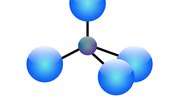
Covalent bonding occurs when two or more atoms share one or more pairs of electrons. The layers of electrons spinning around an atom's nucleus are stable only when the outermost layer has a specified number. Compare this chemical property to a three-legged stool -- in order for it to be stable, it must have at least three legs. Atoms function the same way, as stability depends on the right number of electrons.
Bi-atomic Molecules
The most common covalent bond is present in bi-atomic molecules, or those composed of two of the same atoms. Oxygen occurs naturally as O2, and hydrogen (H2) and chlorine (Cl2) appear in nature the same way.
Single Electron Bonds
Chlorine and hydrogen form by sharing one pair of electrons. This means in each atom's outermost electron layer, one electron from each atom pair and are shared between the two atoms. Methane gas, or CH4, is also formed through a single electron bond. Each hydrogen atom shares of one electron with the carbon atom. As a result, the carbon atom has a stable number of eight electrons in its outer layer, and each hydrogen atom has the full complement of two electrons in its lone layer.
Double Electron Bonds
A double covalent bond is formed when pairs of atoms share two electrons between them. As can be expected, these compounds are more stable than hydrogen or chlorine because the bond between the atoms is twice as strong as single-electron covalent bonds. The O2 molecule shares 2 electrons between each atom, creating a highly stable atomic structure. As a result, before oxygen will react with another chemical or compound, the covalent bond must be broken. One such process is electrolysis, the formation or breakdown of water into its chemical elements, hydrogen and oxygen.
Gaseous at Room Temperature
Particles formed via covalent bonding are gaseous at room temperature and have extremely low melting points. While the bonds between atoms in an individual molecule are very strong, the bonds from one molecule to another are very weak. Because the covalently bonded molecule is highly stable, the molecules have no chemical reason to interact with one another. As a result, these compounds remain in a gaseous state at room temperature
Electrical Conductivity
Covalently bonded molecules differ from ionic compounds in another way. When an ionically bonded compound, such as common table salt (sodium chloride, NaCl) is dissolved in water, the water will conduct electricity. The ionic bonds are broken down in the solution and the individual elements convert into positively and negatively charged ions. However, because of the strength of the bond, once a covalent compound has cooled to a liquid, the bonds do not break down into ions. As a result, a solution or liquid state of a covalently bonded compound does not conduct electricity.
References
About the Author
Since 2003, Timothy Burns' writing has appeared in magazines, management and leadership papers. He has contributed to nationally published books and he leads the Word Weavers of West Michigan writers' group. Burns wrote "Forged in the Fire" in 2004, and has published numerous articles online. As a trained conference speaker, Burns speaks nationally on the art, science and inspiration of freelance writing.
Photo Credits
Jupiterimages/liquidlibrary/Getty Images
